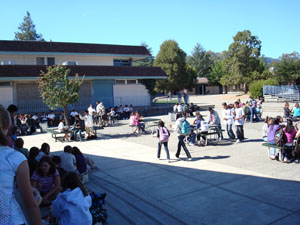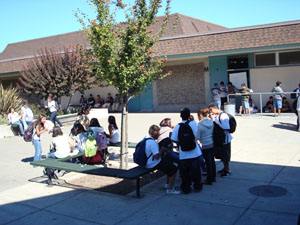 Middle school. Junior high. These are words that often bring up humiliating memories of sweaty palms at school dances and frustrated tears in the girls’ bathroom. People tend to raise their eyebrows when I say that I’m returning to middle school and say, “Well, THAT should be interesting. I would never go back.”
Middle school. Junior high. These are words that often bring up humiliating memories of sweaty palms at school dances and frustrated tears in the girls’ bathroom. People tend to raise their eyebrows when I say that I’m returning to middle school and say, “Well, THAT should be interesting. I would never go back.”
I first set foot on the campus of Altimira Middle School as a grown-up a few weeks ago, when I introduced Reschool Yourself at the weekly staff meeting. Afterward, I stuck my head into the gym and watched the kids run around in their P.E. uniforms, a flood of memories of relays and tumbling and square dancing came back. Without warning, I felt tears welling up. It was bizarre, because I hadn’t realized that my middle school memories still carried such a strong emotional charge. Clearly, there would be some psychological processing in my future.
 This Monday morning, I took a walk around campus before meeting the sixth grader I’d be shadowing for the next few days. The campus looks almost the same as it did in the early 90s, and probably well before that. The biggest difference is that half the portables where I’d had most of my classes in 6th and 8th grades are now gone, and a new cafeteria stands in their place. The school now also has more tables in “the plaza” where kids hang out during break and lunch, so kids can choose to sit in tight clusters or stand with their heads together, like cattle in a patch of shade. Just walking around campus continued to trigger memories from almost 20 years ago. The steps where I’d had a major fight one morning with a friend and didn’t speak to her again until the following year. The computer lab where I’d learned to type “the quick brown fox jumped over the lazy dogs” over and over. The bus circle where I’d waited to leave for a five-day Outdoor Education trip.
This Monday morning, I took a walk around campus before meeting the sixth grader I’d be shadowing for the next few days. The campus looks almost the same as it did in the early 90s, and probably well before that. The biggest difference is that half the portables where I’d had most of my classes in 6th and 8th grades are now gone, and a new cafeteria stands in their place. The school now also has more tables in “the plaza” where kids hang out during break and lunch, so kids can choose to sit in tight clusters or stand with their heads together, like cattle in a patch of shade. Just walking around campus continued to trigger memories from almost 20 years ago. The steps where I’d had a major fight one morning with a friend and didn’t speak to her again until the following year. The computer lab where I’d learned to type “the quick brown fox jumped over the lazy dogs” over and over. The bus circle where I’d waited to leave for a five-day Outdoor Education trip.
I became a sixth grader in 1991, just as junior high schools were being converted into middle schools, much to my chagrin. Right on the brink of becoming a big sixth grader and top dog at my elementary school, I instead had to become a little sixth grader at Altimira. I remember how huge the campus had seemed at first, and how foreign it was to have seven classes in a day and multiple teachers instead of building a relationship with one teacher and one set of classmates. I remember how being popular — or at least avoiding being unpopular — suddenly became more important than anything else. Even as a grown-up, I felt apprehensive about reentering this culture. I wondered if I’d have anyone to eat lunch with and already missed my elementary school fan club.
Before class, I met the student I’d be shadowing, a reed-thin Chinese girl with long black hair that I’ll call Jane (FYI, I usually change the kids’ names when I write about them). Though very quiet, she didn’t seem being my sixth grade guide. The bell rang, and I filed into class with the other kids for Language Arts and took a seat in an empty desk a few seats behind Jane. The kids didn’t seem to pay much attention to me, seemingly half asleep early on the Monday morning. The teacher passed out the newsletter, still called “Altimira Alert” and printed on bright yellow paper as it was in the 90s but now translated into Spanish on the reverse side. On the loudspeaker, the principal cheerily read the morning announcements and wished us a “MAH-velous” Monday, a word which several of the kids echoed like aristocrats.
The Language Arts and Social Studies teacher, who’d been at Altimira in my day but hadn’t been a teacher of mine, introduced me as a former student coming back to write a book. The kids assessed me with varying degrees of interest and turned back to the teacher to get their instructions for the week. Homework was on the board, there would be a test tomorrow on the reading, and this period we’d be doing a handout on common and proper nouns. I looked around the room, noting a couple differences from elementary school. Instead of table groups, kids were seated in traditional rows. They didn’t have cubbies anymore and kept their backpacks by their sides on the floor. The structure seemed to foster more independence and isolation from one’s classmates.
When they’d finished their handouts, a bunch of kids swarmed my desk. “What class do you have second period?” one asked. “What do you have for fourth?” said another.
I handed over my schedule — a copy of Jane’s — and the kids began exclaiming, “She’s with me fourth period!” or “I have all my classes with her!” I had never felt so popular back in my own middle school days, and I was relieved to be making friends after all. Having worked with middle schoolers as a youth program leader for the last five years, I know that sixth graders still like being around adults; in the coming weeks, I expect that the seventh and eighth graders might not be so into me.
The kids all seemed to get along with each other fairly well. I didn’t notice any “untouchables,” but wondered if, as a grown-up, I was just oblivious to preteen politics. I noticed a couple of androgynous kids, with stringy shoulder-length hair, baggy jeans, and Airwalk skater shoes. One had a unisex name like “Pat,” and I didn’t know she was a girl until she joined us in the locker room. She and the other odd ducks seemed to have their own niche like each of the other kids, rather than getting teased. I remembered that in sixth grade I was still somewhat of a tomboy myself and often wore black sweatpants and high-top Nike Airs. I wore no makeup until 8th grade and didn’t learn to use a curling iron until after college.
I flipped through the heavy Language Arts textbook and wondered what Emily Dickinson would have thought about having her poems included in a standardized curriculum, with “Questions for Understanding” after each one. I read an interview with Hatchet author Gary Paulsen, who said that he had been a poor student and had become a writer through years of effort. I wondered how many potential Gary Paulsens were currently doing poorly in this Language Arts class and hoped that they’d find their calling even if their grades didn’t reflect their talents.
The bell rang, and in a shuffle of slamming textbooks shut and zipping up backpacks, the kids crowded out the door to get to second period.
Wow, wonderful post. It gave me that “book” feeling again. A few specifics:
“like cattle in a patch of shade” may well turn into a textbook example for simile, since it so exactly describes knots of pre-teens on the blacktop! (‘plaza’ to you)
It’s nice to see niches still allowed their own space, but now I’m a bit afraid of future descriptions, because as you noted, this sort of mute acceptance often disappears for a while in the pecking-order scramble.
In my own experience, 1st-8th grades were on the same ‘campus,’ so while there was none of the little-fish-big-pond transitions (just wait for 9th grade), the change to rotating teachers and lockers was still a big deal. At least now if you hated a teacher, you had only had him or her for a period or two, not the whole day. I definitely liked the variety!
Wow, I totally need to re-read ‘The Hatchet.’
I.
HATED.
MIDDLE SCHOOL.
6th grade was cool (I was allowed to be a big fish 6th grader and stay in elementary school). I do remember ganging up on a poor girl and making her eat a hot dog when she didn’t want to. Oh popularity, how foolish you make us.
7th grade was REALLY bad but 8th grade was not as bad. I remember you and Gillie visited the summer of 8th grade (going into ninth).
I think I should do a reschool experience too just to feel loved in 7th grade and erase the bad memories.
Oh, middle school. Such a special time.
I went to a fairly sheltered middle school program (because my school was kindergarten through eighth grade, the sixth, seventh and eighth grades had about 150 people total). Even though it was contained, it was total hell. We had the usual cattiness, plus the added disadvantage of having known each other since we were 5. Everyone knew everything about everyone. I missed an unreasonable number of days in middle school (we’re talkin’ more than 20 days per school year) because I was so anxious that I made myself sick.
I’ve always struggled with where I would send my kids for those grades. I cannot imagine what it must be like to go to a huge public middle school. Cramming 2,000 underdeveloped, insecure young adults into an enormous building with minimal supervision? Ummm, yeah…thanks, but no thanks.
I have to say that the experience of being at the bottom of the heap in terms of physical development (I didn’t hit puberty until 14, after I entered high school) and popularity made me a better person in some respects. I just wish I would’ve had a crystal ball so that I wouldn’t have shed so many tears over it then.
Lynnie, I can’t picture you forcing a girl to eat a hot dog! Yes, I’d recommend spending a day in 7th grade to see just how much cooler and more confident you are now, and realize that if you met any of the snobby girls you could hold your own.
Katie, I had a similar experience of rampant cattiness and gossipping. I haven’t observed much of that so far, though again, it may just be under my radar now that I’m an adult. I’m really curious about whether now that kids grow up so quickly, and that many of the Latino kids care for a lot of family members from a young age, there has been any shift toward a more caring culture in middle schools. I did see a lot of teasing going on in the middle schools I worked at in Redwood City, but not as much at Altimira.
Wouldn’t it be wonderful if, during really rough patches, your future self could tell your current self that you really will be OK?